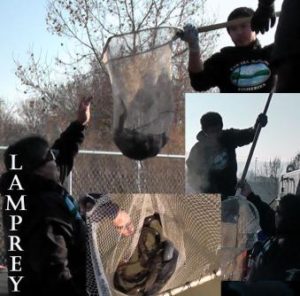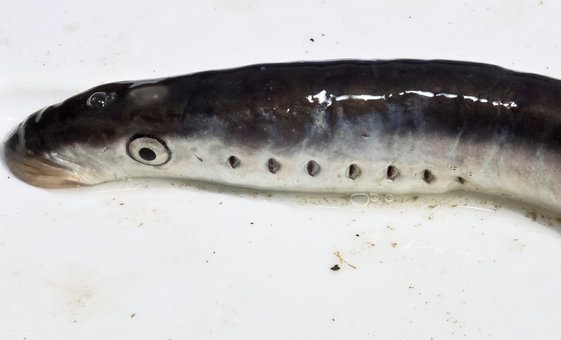The Yakama Nation is working to restore natural production of Pacific lamprey to a level that will provide robust species abundance, significant ecological contributions and meaningful harvest within the Yakama Nations Ceded Lands and in the Usual and Accustomed areas.
In April of 2017, biologists with the Yakama Nation Fisheries released 170 Pacific lamprey into Methow Valley rivers over the past two weeks in an effort to rebuild the dwindling population of the eel-like fish.
 This is the second year that the fish have been released in the Methow Valley, said Ralph Lampman, a research biologist specializing in lamprey. Lampreys are native to the Methow River and are a traditional food of the Yakama people. “They are an ancient fish. They have been around since before the dinosaurs,” Lampman said
This is the second year that the fish have been released in the Methow Valley, said Ralph Lampman, a research biologist specializing in lamprey. Lampreys are native to the Methow River and are a traditional food of the Yakama people. “They are an ancient fish. They have been around since before the dinosaurs,” Lampman said
They are developing a long-term Management and Action Plan, specific to Pacific lamprey, in cooperation with local and regional government entities and other ongoing efforts conducted by the Nez Perce, Umatilla, and Warm Springs Tribes.
The plan is consistent with the Columbia River Inter-Tribal Fisheries Commission Pacific Lamprey Tribal Recovery Plan, the U.S. Fish and Wildlife Service Conservation Initiative, and the Lamprey Management Plans of Chelan County, Douglas County and Grant County Public Utility Districts.
Program Objectives over the next 10-years:
- Document historic distribution of adult lamprey based on historical records, literature reviews and oral interviews, then compare with known current distribution.
- Participate in and contribute to regional consistency in data collection, data management, analysis and reporting.
- Document status of larval Pacific lamprey with presence/absence surveys to determine current distribution.
- Document biologic condition, migration behaviors and environmental cues that trigger migration for both adult and juvenile Pacific lamprey.
- Identify habitat characteristics that are preferred at various life stages and determine the extent these habitats are available and are being utilized (habitat mapping).
- Identify and inventory all known and potential limiting factors, and current threats existing in tributary habitats. Develop and implement a Pacific Lamprey Action Plan for the following subbasins: Methow, Entiat, Wenatchee, Crab Creek, Yakima, Rock Creek, Klickitat, White Salmon, Wind, and Little White Salmon (including all perennial tributary streams to the Columbia River within the Yakama Nation Ceded Lands).
- To increase larval abundance in tributary streams, implement a pilot adult Pacific lamprey translocation program from main-stem Columbia River hydro-electric projects into various subbasins (to be determined) and evaluate methodology and potential ecological benefits and risks of expanding this program as appropriate.
- Evaluate the potential for adult Translocation, and participate in the development of supplementation / artificial propagation techniques of Pacific lamprey.
Project plan:
The Yakama Nation Pacific Lamprey Project is just beginning to develop. There is a rapidly evolving regional awareness of the issues surrounding these fish, but basic information is needed and there is much work to be completed in regional coordination, in data collection methods, data interpretation and reporting formats. Given this, it is impossible to describe all aspects over the next 10-years. Adaptive Management will play a significant role in the development and implementation.
Pacific lamprey photo by Bill Stagnaro via Wikipedia.
See Methow Valley News article about release.
See Yakama lamprey restoration webpage & photo collage credit.

